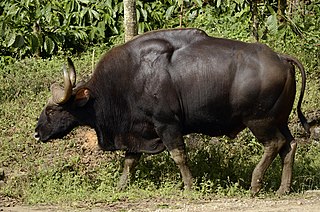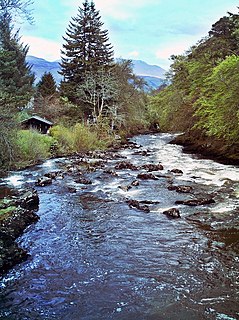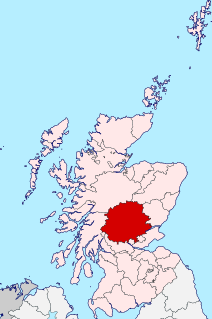
The gaur, also called the Indian bison, is the largest extant bovine. This species is native to South and Southeast Asia. It has been listed as Vulnerable on the IUCN Red List since 1986. Population decline in parts of its range is likely to be more than 70% during the last three generations. However, population trends are stable in well-protected areas, and are rebuilding in a few areas which previously had been neglected.

Strathearn or Strath Earn is the strath of the River Earn, in Scotland. It extends from Loch Earn to the River Tay, and was bounded on the north by Atholl, north west by Breadalbane, south west by Menteith, south east by Fife, and on the east by Perthia. The region formed a traditional province of Scotland, and hence had a mormaer and then an Earl.

Menteith or Monteith, a district of south Perthshire, Scotland, roughly comprises the territory between the Teith and the Forth. The region is named for the river Teith, along with the Gaelic for morass, moss or bog. Early forms including Meneted, Maneteth and Meneteth. The area between Callander and Dunblane was historically known in English as the Vale of Menteith.

The Campsie Fells are a range of hills in central Scotland, stretching east to west from Denny Muir to Dumgoyne, in Stirlingshire and overlooking Strathkelvin to the south. The southern extent of the range fall within East Dunbartonshire. The range overlooks the villages of Strathblane, Blanefield and Lennoxtown to the south; Killearn to the west; Fintry and Strathendrick to the north. The Fintry Hills lie further to the north; Kilpatrick Hills lie to the west and the Kilsyth Hills to the east.

Ben Lui is a mountain in the southern Highlands of Scotland, at the head of Glen Fyne. It has five well-defined ridges radiating out from the summit. Four corries lie between the ridges; including Coire Gaothaich which lies on the northeast side of the mountain.

The River Leven is a stretch of water in West Dunbartonshire, Scotland, flowing from Loch Lomond in the North to the River Clyde in the South. The total length of the river is approximately six miles and is very popular with salmon and sea trout anglers, trying to catch one of these migratory fish going up to Loch Lomond.

The River Leven is a river in Fife in Scotland. It flows from Loch Leven into the Firth of Forth at the town of Leven. The river is home to brown trout and hosts a run of sea trout and atlantic salmon. The estuary has bass and mullet.
The River Isla is a tributary of the River Tay in Angus and Perthshire, Scotland. It runs for 46 miles (74 km) through the Kirkton of Glenisla and Strathmore.

The River Dochart is in Perthshire, Scotland.
Glen Lyon is a glen in the Perth and Kinross region of Scotland. It is the longest enclosed glen in Scotland and runs for 34 miles from Loch Lyon in the west to the village of Fortingall in the east. This glen was also known as "An Crom Ghleann",. The land given over to the MacGregors was Scottish Gaelic: An Tòiseachd. It forms part of the Loch Rannoch and Glen Lyon National Scenic Area, one of 40 such areas in Scotland, which are defined so as to identify areas of exceptional scenery and to ensure its protection from inappropriate development by restricting certain forms of development. Sir Walter Scott described Glen Lyon as the longest, loneliest and loveliest glen in Scotland.
The MSU Pavilion for Agriculture and Livestock Education is a convention center located in East Lansing, Michigan on the campus of Michigan State University. It was built in 1996. It has 101,527 square feet (9,432 m2) of exhibit space.

Glenfarg is a small village in the Ochil Hills in the county of Perth and Kinross, central Scotland. Until 14 June 1964, the village had a railway station on the main line between Perth and Edinburgh via Kinross. Although not recommended for closure under the Beeching Axe, the line nevertheless closed to passengers and freight on 5 January 1970, resulting in slower passenger services to Perth via longer routes. The former railway line is now the route of the M90 motorway, which runs along the eastern periphery of the village. At its peak, the village became a popular holiday destination, boasting 4 hotels. Services in the village include a church, small shop, tennis courts, riding school, primary school with nursery.
Glen Dochart in Perthshire, Scottish Highlands is a glen which runs from Crianlarich eastwards to Killin, following the course of the River Dochart as it flows through Loch Dochart and Loch Iubhair. It is met by Glen Ogle at Lix Toll. Lochan Saorach lies within the glen and was once famous for its Floating island.

The Endrick Water or River Endrick is a river which flows into the eastern end of Loch Lomond, Scotland.
This is a list of the extreme points and extreme elevations in Scotland.

The River Pinn is a river in the county of Middlesex, in the western part of Greater London, which originates in Harrow Weald and flows into the Frays River, a distributary of the River Colne.

Matla River forms a wide estuary in and around the Sundarbans in South 24 Parganas district in the Indian state of West Bengal.

The River Ardle is a tributary of the River Ericht. It runs for 10 miles (16 km) through Strathardle in Perthshire, Scotland. It is a salmon and trout river.
Murthly is a village in Perth and Kinross, Scotland. It is located on the south bank of the River Tay, 7 kilometres (4.3 mi) south-east of Dunkeld, and 15 kilometres (9.3 mi) north of Perth. Perth District Asylum, later known as Murthly Hospital, was opened in the village on 1 April 1864 for 'pauper lunatics'. It was the second district asylum to be built in Scotland under the terms of the 1857 Lunacy (Scotland) Act. It closed in 1984 and was later demolished. A stone circle is located within the village, in the former grounds of the hospital. The village formerly had a railway station on the Perth and Dunkeld Railway.
Bugaba is a corregimiento in Bugaba District, Chiriquí Province, Panama. It has a land area of 12.9 square kilometres (5.0 sq mi) and had a population of 3,718 as of 2010, giving it a population density of 288.6 inhabitants per square kilometre (747/sq mi). Its population as of 1990 was 1,989; its population as of 2000 was 2,817.


















